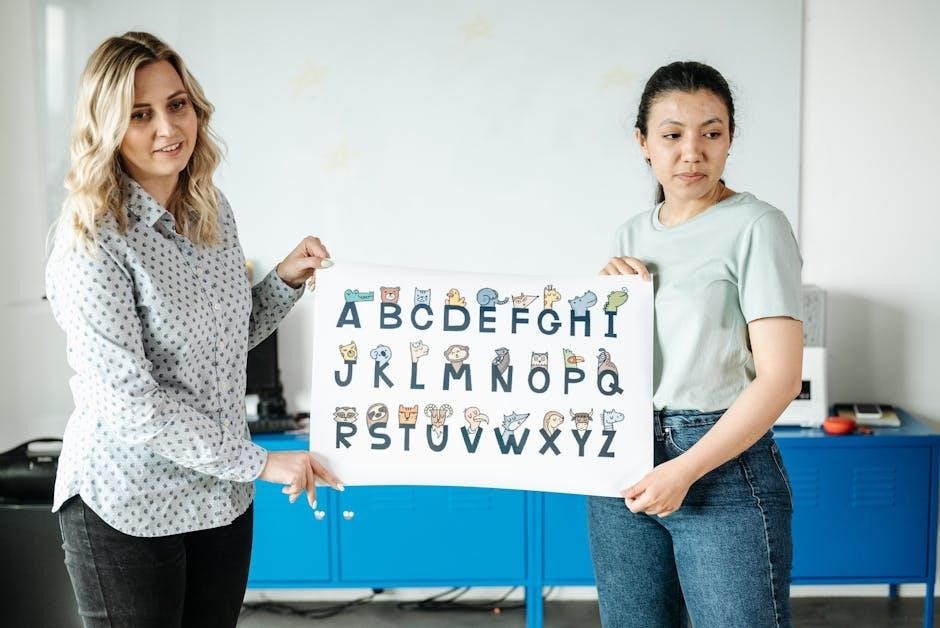Pointillism is an art technique using small dots to create images. The crossword clue “Teachers instruction in a class on pointillism?” answers with “Doasisaydotasido‚” reflecting its educational value in teaching color theory and creativity.
What is Pointillism?
Pointillism is an artistic technique that involves creating images using small‚ distinct dots of color. These dots are applied in patterns to form a larger image when viewed from a distance. The technique relies on the optical blending of colors‚ allowing the viewer’s eye to mix the dots into a cohesive picture. Pointillism emerged as a revolutionary method in the late 19th century‚ emphasizing scientific color theory and precision. It contrasts with traditional painting methods by focusing on dots rather than brushstrokes‚ creating a unique visual effect. Artists like Georges Seurat and Paul Signac pioneered this style‚ which continues to inspire modern art education. The crossword clue “Doasisaydotasido” humorously captures the essence of Pointillism’s dot-based approach;
The Purpose of Pointillism in Art Education
Pointillism serves as a valuable tool in art education‚ fostering creativity and understanding of color theory. By teaching students to apply small dots‚ it encourages patience and attention to detail. This method helps learners explore how colors interact and blend optically‚ enhancing their grasp of visual perception. It also introduces them to the works of pioneers like Seurat‚ bridging art history with practical skill-building. The crossword clue “Doasisaydotasido” reflects the playful yet instructive nature of teaching Pointillism‚ making it an engaging and memorable experience for students of all ages. Through this technique‚ educators inspire critical thinking and artistic expression in a structured‚ innovative way.
Relevance of Pointillism in Modern Teaching
Pointillism remains highly relevant in modern education‚ offering cross-curricular benefits. It aligns with National Core Arts Standards‚ emphasizing artistic creation and conceptualization. Educators use Pointillism to integrate math‚ teaching measurement and estimation through dot patterns. Its adaptability makes it suitable for various age groups‚ from elementary to high school. The technique encourages creativity‚ critical thinking‚ and fine motor skills. Resources like lesson plans on Teachers Pay Teachers and interactive activities‚ such as Q-tip painting‚ make it accessible. The crossword clue “Doasisaydotasido” highlights its engaging potential as a teaching tool‚ proving Pointillism’s enduring value in fostering both artistic and academic growth in contemporary classrooms.

History of Pointillism
Originating in the late 19th century‚ Pointillism emerged as a revolutionary art movement pioneered by Georges Seurat and Paul Signac. It evolved from Impressionism‚ focusing on dot-based techniques to create vivid images. The crossword clue “Doasisaydotasido” reflects its enduring influence in art education and cultural significance.
Key Artists: Georges Seurat and Paul Signac
Georges Seurat‚ the founder of Pointillism‚ is renowned for his iconic work A Sunday Afternoon on the Island of La Grande Jatte. Paul Signac‚ a close collaborator‚ further developed the technique. Both artists relied on optical mixing‚ applying small dots of pure color to create vibrant‚ detailed images. Their innovative approach influenced modern art and remains a cornerstone in art education. The crossword clue “Doasisaydotasido” highlights their legacy‚ emphasizing the educational value of their work in teaching color theory and artistic methods. Seurat and Signac’s contributions continue to inspire educators and artists‚ making Pointillism a timeless and engaging subject in classrooms worldwide.
Evolution of Pointillism from Impressionism

Pointillism emerged as a response to Impressionism‚ adopting its emphasis on light and color but introducing a more scientific approach. Artists like Georges Seurat and Paul Signac moved away from Impressionism’s spontaneous brushstrokes‚ instead using small‚ precise dots to create detailed compositions. This technique‚ known as optical mixing‚ allowed for greater chromatic intensity and depth. The evolution from Impressionism to Pointillism marked a shift toward a more structured and methodical art form‚ blending artistic expression with scientific principles. The crossword clue “Doasisaydotasido” encapsulates this transition‚ reflecting the technique’s educational significance in teaching color theory and composition. This method remains a cornerstone in art education‚ bridging art and science.
Notable Works and Their Significance
Georges Seurat’s A Sunday Afternoon on the Island of La Grande Jatte is a landmark of Pointillism‚ showcasing the technique’s potential for detail and emotion. Paul Signac’s vibrant seascapes further expanded its reach. These works demonstrate how Pointillism blends science with art‚ using dots to create optical effects. The crossword clue “Doasisaydotasido” reflects the method’s educational value‚ as teachers often use it to illustrate color theory. These pieces remain vital in art education‚ inspiring students to explore the interplay of color and composition. Their significance lies in their ability to teach both artistic technique and the principles of visual perception‚ making them timeless examples of innovative artistry.

Techniques of Pointillism
Pointillism involves applying small dots of color to create detailed images. This method relies on the viewer’s eye to blend the dots‚ achieving vibrant‚ optical effects through careful color placement and layering.
The Science of Color Mixing in Pointillism
Pointillism relies on optical color mixing‚ where small dots of pure color are applied in patterns to create vibrant‚ luminous effects. By layering primary and secondary hues‚ artists achieve a broader spectrum of tones. This technique‚ rooted in color theory‚ demonstrates how the human eye blends nearby dots into a cohesive image. The method emphasizes contrast and harmony‚ allowing for dynamic visual impact. The crossword clue “Doasisaydotasido” reflects this process‚ as it mirrors the repetitive‚ precise application of dots. Understanding this scientific approach to color is essential for mastering Pointillism‚ making it a valuable educational tool for teaching art and perception.
Tools and Materials for Creating Pointillist Art
Pointillist art requires specific tools and materials to achieve its distinctive effect. Small‚ precise brushes or dotting tools are essential for applying tiny dots of paint. Canvas or paper with a smooth texture is ideal for maintaining clarity. Acrylic or oil paints are commonly used‚ offering vibrant colors. Additionally‚ Q-tips and sticker dots are popular in educational settings for simplicity. The crossword clue “Doasisaydotasido” hints at the repetitive process‚ emphasizing the need for patience and precision. These materials and tools enable artists to explore the technique effectively‚ making Pointillism accessible to both professionals and students in structured lessons.
Step-by-Step Guide to Painting in Pointillism
Begin by preparing your surface with a primed canvas or paper. Sketch your composition lightly with a pencil. Mix your colors on a palette‚ focusing on vibrant hues. Using small brushes or Q-tips‚ apply tiny dots of paint in organized patterns‚ layering to build depth. Allow each layer to dry before adding more dots. Blend colors optically by placing contrasting dots side by side. Avoid mixing on the canvas; instead‚ let the viewer’s eye merge the colors. Finish by varnishing to protect the artwork. The crossword clue “Doasisaydotasido” reflects the repetitive process‚ encouraging patience and precision in creating intricate‚ detailed pieces.

Lesson Plan Overview
This 2nd-grade lesson plan spans four sessions‚ focusing on math skills like measuring lengths while introducing pointillism techniques. The crossword clue ‘Doasisaydotasido’ reinforces the method creatively.
Grade Level and Appropriateness
Pointillism lessons are adaptable across grade levels‚ making it suitable for students aged 4-8 and beyond. For younger students‚ activities like Q-tip painting or sticker dots simplify the technique‚ fostering creativity. Older students can explore advanced color theory and historical context. The crossword clue “Doasisaydotasido” engages middle schoolers‚ aligning with educational standards. This method bridges art and math‚ teaching measuring skills and artistic expression. Its versatility ensures it meets diverse learning needs‚ making it a valuable addition to art curricula.
Core Content and Learning Objectives
Pointillism lessons focus on teaching students to create artworks using dot techniques‚ emphasizing color theory and composition. Learning objectives include understanding how dots blend to form images‚ exploring historical artists like Seurat‚ and applying math skills such as measuring lengths. Students learn to generate artistic ideas‚ organize their work‚ and connect art to broader subjects. The crossword clue “Doasisaydotasido” reinforces these concepts‚ encouraging critical thinking. By the end of the lesson‚ students should demonstrate an ability to apply pointillism techniques‚ analyze artworks‚ and reflect on their creative process. These objectives align with educational standards‚ fostering both artistic and analytical skills.
Number of Sessions and Duration
A pointillism lesson plan typically spans four classroom sessions‚ each lasting approximately 60-90 minutes. The first session introduces the technique‚ covering its history and key artists like Seurat. Subsequent sessions focus on practical application‚ with students creating their own pointillist artworks. The final session allows for reflection and sharing of completed projects. This structured approach ensures students grasp the fundamentals of color mixing‚ composition‚ and the patience required for detailed work. The duration is designed to accommodate hands-on activities‚ discussions‚ and assessments‚ ensuring a comprehensive learning experience aligned with educational standards.

Activities and Exercises
Engaging activities include Q-tip pointillism‚ sticker dots for younger students‚ and creating self-portraits in the style of Chuck Close‚ fostering creativity and technique mastery.
Q-Tip Pointillism: A Fun and Interactive Activity
Q-tip pointillism is a engaging way to introduce students to the technique. Using Q-tips dipped in paint‚ students create vibrant artworks by applying small dots. This hands-on activity teaches color mixing and the principles of pointillism. Materials include large paper‚ paint‚ Q-tips‚ and smocks. Students learn to layer dots to form shapes and hues‚ mimicking Seurat’s style. The activity is ideal for grades 3-8‚ fostering creativity and fine motor skills. Teachers can display finished works to showcase understanding. This method makes complex art techniques accessible‚ allowing students to explore their artistic potential while learning about art history in a playful manner.
Using Sticker Dots for Younger Students
Sticker dots are a perfect tool for introducing pointillism to younger students. They allow children to create artwork by placing small‚ colored dots on paper. This method is mess-free and easy to handle‚ making it ideal for students as young as preschool age. Teachers can provide pre-cut sticker dots in various colors‚ along with examples of pointillist art. Students then arrange the dots to form images‚ learning about color mixing and composition. This activity enhances fine motor skills and creativity while teaching the basics of pointillism. It is a simple yet effective way to engage young learners in art education‚ fostering an early appreciation for artistic techniques and history.
Creating Self-Portraits in the Style of Chuck Close
Chuck Close‚ a renowned artist‚ popularized pointillism through his large-scale portraits. Students can create self-portraits using his technique by breaking images into grids. Each section is filled with colored dots or small shapes‚ which‚ when viewed from a distance‚ form a detailed image. This activity teaches students about color theory‚ scale‚ and composition. Using grid paper and colored markers or dots‚ students learn to translate their features into tiny‚ organized elements. This method encourages patience and attention to detail while fostering creativity. It also introduces students to the concept of optical mixing‚ where individual dots blend to create a cohesive image. This exercise bridges art and math‚ making learning engaging and interdisciplinary.

Cross-Curricular Connections

Pointillism bridges art with math‚ history‚ and creativity. It encourages critical thinking through color theory and historical context‚ making it a versatile tool for interdisciplinary learning experiences.
Integrating Math: Measuring and Estimating Lengths
Pointillism seamlessly integrates math through measuring and estimating lengths. For instance‚ students can measure the spacing between dots to understand proportion and scale. This activity aligns with math standards‚ such as CC.2.4.2.A.1‚ which focuses on measuring and estimating lengths of objects. By applying mathematical concepts to art‚ students develop a deeper understanding of both fields. This cross-curricular approach enhances problem-solving skills and encourages students to view math as a practical tool in creative processes. Such activities make learning engaging and relevant‚ bridging the gap between abstract concepts and real-world applications.
Connecting Art to History and Culture
Pointillism connects art to history and culture by reflecting the late 19th-century Parisian art scene‚ where artists like Georges Seurat and Paul Signac pioneered the technique. This movement emerged as a response to Impressionism‚ blending science and creativity. By studying Pointillism‚ students gain insights into the cultural shifts of the time‚ including the rise of modern art movements. Exploring historical context helps students appreciate how Pointillism influenced later artists and styles. This cross-curricular approach fosters a deeper understanding of art as a reflection of societal values and technological advancements‚ making it a valuable tool for teaching history and cultural awareness in the classroom.
Encouraging Creativity and Critical Thinking
Pointillism fosters creativity and critical thinking by challenging students to experiment with color and technique. Activities like Q-tip pointillism or sticker dot art encourage students to think innovatively about how small dots can form complex images. This method teaches patience and attention to detail‚ while also allowing students to express their personal style. The crossword clue “Doasisaydotasido” hints at the playful nature of learning pointillism‚ making it engaging. By analyzing how colors blend and how patterns emerge‚ students develop problem-solving skills and artistic confidence. This approach not only enhances creativity but also helps students understand the relationship between individual elements and the whole‚ promoting deeper critical thinking in art and beyond.

Resources and References
Recommended books‚ online platforms like Duckspter‚ Sotheby’s‚ and WideWalls offer insights into pointillism. Teachers Pay Teachers provides lesson plans‚ while crosswords like “Doasisaydotasido” engage students interactively.
Recommended Books and Articles on Pointillism
For a deeper understanding‚ explore books like “Ways of Pointillism: Seurat‚ Signac‚ Van Gogh” (ISBN-10: 3777426342)‚ offering insights into the movement’s history and techniques. Online resources such as Ducksters and WideWalls provide engaging articles for both students and educators. Additionally‚ lesson plans from Curated OER and Teachers Pay Teachers include hands-on activities‚ like Q-tip painting‚ to teach pointillism effectively. These resources help educators explain color theory‚ historical context‚ and practical applications‚ making pointillism accessible and fun for all age groups while aligning with educational standards.
Online Platforms for Teaching Pointillism
Sotheby’s and WideWalls offer comprehensive articles and inspiring artist features‚ ideal for educators seeking detailed insights. For lesson plans‚ platforms like Curated OER and Teachers Pay Teachers provide ready-to-use resources‚ such as Q-tip pointillism activities; Ducksters simplifies the concept for younger students with interactive content. These online tools help teachers create engaging lessons‚ aligning with educational standards and fostering creativity. They also provide practical examples‚ like sticker dot exercises‚ making pointillism accessible for all skill levels. These platforms are invaluable for educators aiming to integrate art history‚ math‚ and critical thinking into their curriculum.
Teachers Pay Teachers: A Marketplace for Lesson Plans
Teachers Pay Teachers (TpT) offers a variety of lesson plans focused on pointillism‚ catering to different grade levels and teaching styles. Educators can find detailed resources‚ including Q-tip pointillism kits and sticker dot activities‚ designed to engage students creatively. These plans often align with core standards‚ making them easy to integrate into curriculum. Many resources are specifically tailored for younger students‚ introducing them to art history and techniques in an accessible way. TpT also provides lesson plans that connect pointillism to math‚ history‚ and critical thinking‚ offering a holistic approach to teaching this artistic method. It’s a go-to platform for innovative and effective educational materials.

Crossword Clue: Teachers Instruction on Pointillism
The crossword clue “Teachers instruction in a class on pointillism?” has the answer “Doasisaydotasido‚” a 16-letter phrase reflecting the artistic technique’s educational application.
Understanding the Crossword Clue
The crossword clue “Teachers instruction in a class on pointillism?” refers to the artistic technique of pointillism‚ where small dots create images. The answer‚ “Doasisaydotasido‚” reflects this method‚ emphasizing the instructional aspect of teaching pointillism. This clue highlights the educational context of the art technique‚ making it relevant for teachers and students alike. It encourages puzzle enthusiasts to connect art history with pedagogical practices‚ showcasing how crosswords can blend learning with entertainment. The clue also underscores the importance of understanding color theory and creativity in art education‚ aligning with the principles of pointillism pioneered by artists like Georges Seurat and Paul Signac.
Answer: “Doasisaydotasido”
“Doasisaydotasido” is the 16-letter answer to the crossword clue “Teachers instruction in a class on pointillism?” This unique phrase phonetically mimics the action of applying dots‚ a core technique in pointillism. It serves as a clever mnemonic‚ helping educators teach students how to create images using small‚ colored dots. The phrase also embodies the method’s essence‚ emphasizing repetition and precision. By remembering “Doasisaydotasido‚” learners can grasp the fundamental approach of layering dots to form detailed visuals‚ making it an engaging and memorable teaching tool in art education.
How to Use Crosswords as a Teaching Tool
Crosswords are an engaging way to teach students about pointillism‚ enhancing vocabulary and critical thinking. By incorporating art-related terms‚ educators can create puzzles that introduce key concepts like “pointillism‚” “Seurat‚” and “color mixing.” This interactive method makes learning fun and challenging. Crosswords also encourage problem-solving skills‚ as students decipher clues related to art history and techniques. Teachers can design crosswords tailored to specific lessons‚ ensuring alignment with curriculum goals. For instance‚ a crossword featuring the clue “Teachers instruction in a class on pointillism?” with the answer “Doasisaydotasido” reinforces the method’s core principle. This tool fosters creativity and retention‚ making complex art concepts accessible and memorable for students of all ages.
Pointillism’s educational value shines through crosswords like “Doasisaydotasido‚” making art concepts engaging and memorable for students while fostering creativity and critical thinking in the classroom setting effectively.
Summarizing the Importance of Pointillism in Education
Pointillism is a valuable educational tool‚ teaching students about color theory‚ patience‚ and creativity. The crossword clue “Doasisaydotasido” highlights its relevance in engaging students with art history. By breaking images into dots‚ students learn to visualize and reconstruct compositions‚ fostering critical thinking. This technique aligns with educational standards‚ encouraging the exploration of artistic ideas and their execution. Pointillism also connects to math through measuring and estimating‚ making it a cross-curricular activity. Its adaptability for various age groups‚ from elementary to high school‚ ensures accessibility and inclusivity. Activities like Q-tip painting or sticker dots make learning interactive and fun‚ while integrating history and culture enriches the experience. Ultimately‚ Pointillism bridges art and education‚ inspiring creativity and skill development in a structured‚ enjoyable manner.
Encouraging Students to Explore Art Techniques
Exploring art techniques like Pointillism fosters creativity and critical thinking in students. Activities such as Q-tip painting or sticker dots make learning interactive and engaging. These methods allow students to experiment with color mixing and composition‚ developing their fine motor skills and patience. By introducing techniques like those used by Georges Seurat‚ students gain insight into art history and cultural significance. Encouraging experimentation with Pointillism helps students build confidence in their artistic abilities while understanding the technical aspects of creating detailed‚ layered images. This hands-on approach not only enhances creativity but also connects art to broader educational goals‚ such as problem-solving and self-expression.
Final Thoughts on Teaching Pointillism
Teaching Pointillism offers a unique opportunity to blend art‚ history‚ and creativity in the classroom. By engaging students with hands-on activities like Q-tip painting or sticker dots‚ educators can make the technique accessible and fun. The crossword clue “Doasisaydotasido” serves as a memorable reminder of the method’s essence. This approach not only teaches color theory and technique but also fosters patience‚ critical thinking‚ and an appreciation for art history. Encouraging students to explore Pointillism helps them develop problem-solving skills and confidence in their artistic abilities. Ultimately‚ integrating Pointillism into lesson plans creates a rich‚ interdisciplinary learning experience that connects art to math‚ history‚ and culture‚ inspiring students to view the world through a creative lens.
